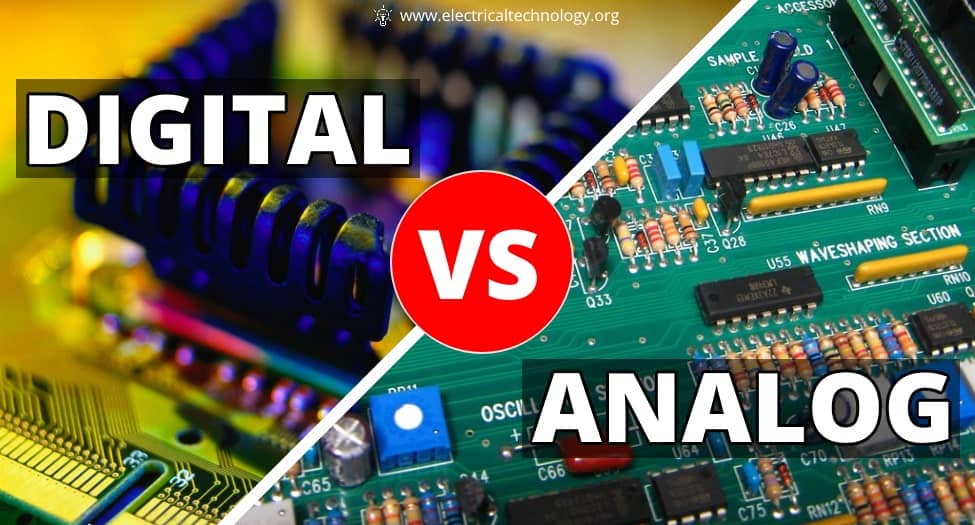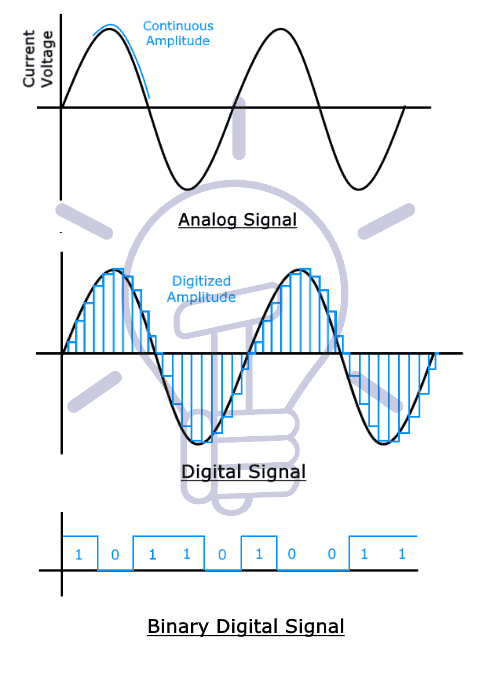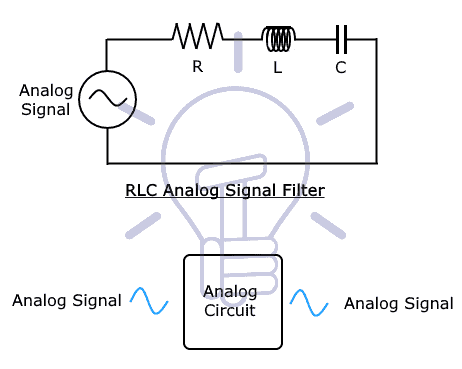Difference between Analog and Digital Circuit – Digital vs Analog
What is the Difference between Analog and Digital Circuit
In our daily life, we use multiple electrical and electronics devices that interact with each other and the real-world through the transfer of information. The information is conveyed using signals that could exist in mainly one of the two forms; Analog and Digital.
The real-world is analog in nature i.e. the information existing in the real-world is analog in nature having infinite possibilities like colors or light intensity and sound etc. but when we digitize or convert these real-world signals into signals having discrete values having finite possibilities we call them the digital signal. We use two different types of circuits to process these signals.
- Related Post: Why Do Electronic Circuits Use DC Current instead of AC?
Before going into the differences between Analog and Digital Circuit, let look into what signals is;
Signal:
A signal is a quantity that varies through time to convey some sort of information. In electrical circuits, the time-varying quantity in a signal can be voltage or current. The information is stored in either its amplitude or frequency or its duty cycle. These signals are used to transfer data or information between circuits or devices. We use different sorts of circuits to encode / decode or modify this information. The signal is classified into two main types;
Analog Signal:
This type of signal is a continuous-time and continuous voltage or amplitude signal. Most of the analog signals can be decomposed into multiple sine waves. The signal may go from positive amplitude to a negative amplitude. The analog signal is more susceptible to the noise which creates distortion in the waveform thus causing the loss of information.
Digital Signal:
The digital signal is a type of signal whose amplitude is not continuous but in a discrete form (fixed values). The most common type of digital signal is the binary form where the amplitude can be either “0” (Low Voltage) or “1” (High Voltage). The digital signals are almost immune to noise i.e. the signal does not get distorted and there is only 2 amplitude values that are easier to differentiate.
Analog Circuit:
The analog circuit is a type of electronic circuit that processes any analog data or signal and provides an analog output. They are made from various analog circuit components such as resistors, capacitors, inductors, etc.
Since the real-world signals exist in analog form, the analog circuit does not need any sort of converters at its input and the data is directly fed to the circuit without any loss. For example, the sound or voice signal exists in an analog form which is converted into an electrical signal using a microphone but it stays in analog form. It can be directly processed by any analog circuit without any loss of information.
The output of an analog circuit is also an analog signal which is easier to feed to any real-world components such as TV, radio, or speaker.
- Related Post: What Happens When an AC Line Touches a DC Line?
The Analog circuit can either be an Active circuit such as amplifiers that needs an extra source to power the circuit or Passive Circuit such as a low pass filter that does not need extra power source but only needs the input signal to power it.
The downside of an analog circuit is that their signal may get distorted and causes to lose the information. Therefore, the accuracy or precision of such circuits deteriorates. Also, they are difficult to design since the components are placed manually.
- Related Post: Difference between AC and DC (Current & Voltage)
Digital Circuit:
The type of electronic circuit that processes data or signal that has discrete amplitude also known as the digital signal is called a digital circuit. They are made from digital logic gates which is the basic building block of any digital circuit.
Since the digital circuit only operates on digital signal, therefore the real-world analog signal much be changed into a digital signal using ADC (Analog to Digital Converter) which can cause loss of information due to sampling. The output digital signal must be converted back into an analog signal using DAC (Digital to Analog Converter) if they are supposed to interact with the real-world components.
The digital circuits can be only Active circuit i.e. they need an extra source of power supply to power the circuit. Because the digital circuits are made from transistors, it is impossible to make a passive digital circuit.
However, most of the digital circuits need a clock signal (a signal oscillating between high and low state) to synchronize the operation of the circuit. It tells the circuit when and how to operate the next command.
- Related Post: AC or DC – Which One is More Dangerous And Why ?
Key Differences between Analog and Digital Circuit
The following comparison table shows the main difference between digital and analog circuits.
| Analog Circuit | Digital Circuit |
| The circuit that can only process Analog or continuous amplitude signal | The circuit that can only process Digital or discrete Amplitude signal |
| The analog signals are a combination of sine waves. | The digital signals are made form square waves or “0” or “1” amplitude |
| The amplitude of the signal can be positive and negative | The amplitude of the signal is only positive |
| It stores the information in the form of wave | It stores the information in a binary form called bits (1 or 0) |
| It can transmit the analog signal wirelessly and with wire | It can transmit the digital signal only through wire |
| It can get the signal from the real-world without any conversion. | Since the real world is analog in nature, it needs ADC to convert analog into a digital signal. |
| The information is not lost while receiving the signal from the real world. | The conversion using ADC causes loss of some information due to sampling. |
| Its output can be directly connected to any real-world components | Its digital output must be converted into the Analog domain in order to connect it to real-world components. |
| The analog domain signals are more susceptible to noise. | They are more resistant to the noise signal. |
| Its design is complex and needs various circuit components that need to be placed manually | They use logic gates and there is multiple software that can help in designing complex digital circuit fairly easy. |
| The analog circuit does not offer flexibility. | The digital circuit implementation is more flexible than analog |
| They do not require any clock signal to process data. | The digital circuits mostly rely on a clock signal to synchronize with each other. |
| The analog circuit can be passive and active circuit | They Digital circuits are only active circuit i.e. they need an extra source of power. |
| The analog circuit is slower in processing and requires more power than the digital circuit | The digital circuits are faster in processing and require less power than the analog circuit |
| The analog circuits are less accurate and precise | Digital circuits are more accurate and precise. |
| The analog instruments can cause observational error or parallax | The digital instruments are free from observational errors. |
| They are not efficient for performing logic-based tasks | They are only used for processing large sum of data or performing logic-based tasks. |
Analog or Digital, Which is Better and Why?
We don’t like stupid questions but we try to answer in any aspect. It is the same question like which number is better, 0, 1 or 39?. To the question, it depends on the applications based on multiple factors. Both digital and analog have advantages and disadvantages.
- For example, a digital recording can be copied hundred of thousands (and so on) and play without losing the quality i.e the copied version is same like the original one. On the other hand, analog recording may lose the quality when copied.
- Digital recordings can be played on various digital devices while analog recordings are not portable as compared to the digital system.
- The SNR (Signal to Noise Ratio) in digital system is greater based on bid depth as compared to the analog.
- The audio bandwidth of analog recording is greater (almost unlimited) than the digital recording.
- The digital system is flexible as it computational and programmable, easy reproduction and repeatable, simple and low cost technology, small size and low power consumption.
Related Posts:
- Difference Between Microprocessor and Microcontroller
- Difference Between 8085 & 8086 Microprocessor – Comparison
- Difference Between CPU and GPU – Comparison
- Difference Between RAM and ROM – Comparison
- Difference Between Electric and Magnetic Circuit
- Difference between Linear and Nonlinear Circuit
- Difference Between Real Ground and Virtual Ground
- Difference Between Neutral, Ground and Earth?
- Difference Between Conductor, Semiconductor and Insulator
- Difference Between Capacitor and Supercapacitor
- Difference Between a Battery and a Capacitor
- Difference Between Voltage and EMF?











Good reading